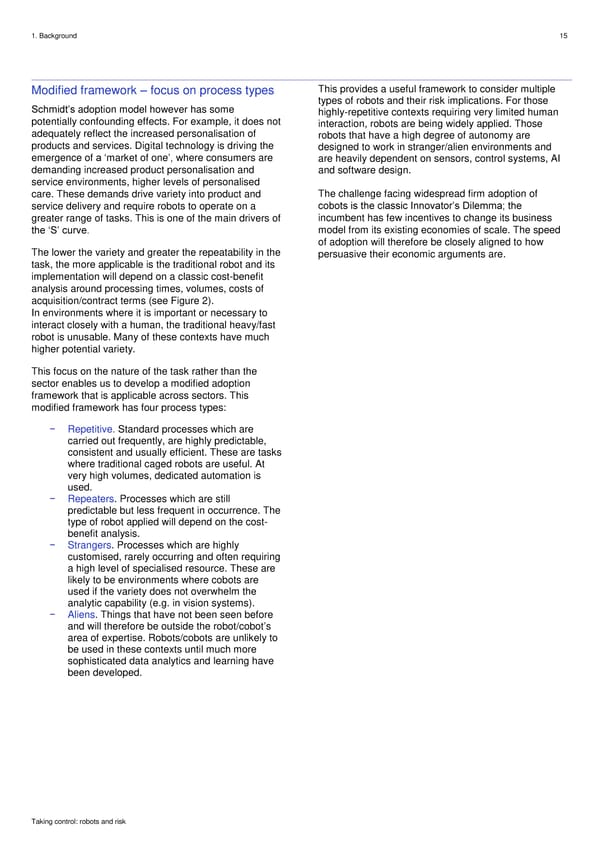1. Background 15 Modified framework – focus on process types This provides a useful framework to consider multiple Schmidt’s adoption model however has some types of robots and their risk implications. For those potentially confounding effects. For example, it does not highly-repetitive contexts requiring very limited human adequately reflect the increased personalisation of interaction, robots are being widely applied. Those robots that have a high degree of autonomy are products and services. Digital technology is driving the designed to work in stranger/alien environments and emergence of a ‘market of one’, where consumers are are heavily dependent on sensors, control systems, AI demanding increased product personalisation and and software design. service environments, higher levels of personalised care. These demands drive variety into product and The challenge facing widespread firm adoption of service delivery and require robots to operate on a cobots is the classic Innovator’s Dilemma; the greater range of tasks. This is one of the main drivers of incumbent has few incentives to change its business the ‘S’ curve. model from its existing economies of scale. The speed of adoption will therefore be closely aligned to how The lower the variety and greater the repeatability in the persuasive their economic arguments are. task, the more applicable is the traditional robot and its implementation will depend on a classic cost-benefit analysis around processing times, volumes, costs of acquisition/contract terms (see Figure 2). In environments where it is important or necessary to interact closely with a human, the traditional heavy/fast robot is unusable. Many of these contexts have much higher potential variety. This focus on the nature of the task rather than the sector enables us to develop a modified adoption framework that is applicable across sectors. This modified framework has four process types: − Repetitive. Standard processes which are carried out frequently, are highly predictable, consistent and usually efficient. These are tasks where traditional caged robots are useful. At very high volumes, dedicated automation is used. − Repeaters. Processes which are still predictable but less frequent in occurrence. The type of robot applied will depend on the cost- benefit analysis. − Strangers. Processes which are highly customised, rarely occurring and often requiring a high level of specialised resource. These are likely to be environments where cobots are used if the variety does not overwhelm the analytic capability (e.g. in vision systems). − Aliens. Things that have not been seen before and will therefore be outside the robot/cobot’s area of expertise. Robots/cobots are unlikely to be used in these contexts until much more sophisticated data analytics and learning have been developed. Taking control: robots and risk
 Robots & Risk Page 14 Page 16
Robots & Risk Page 14 Page 16